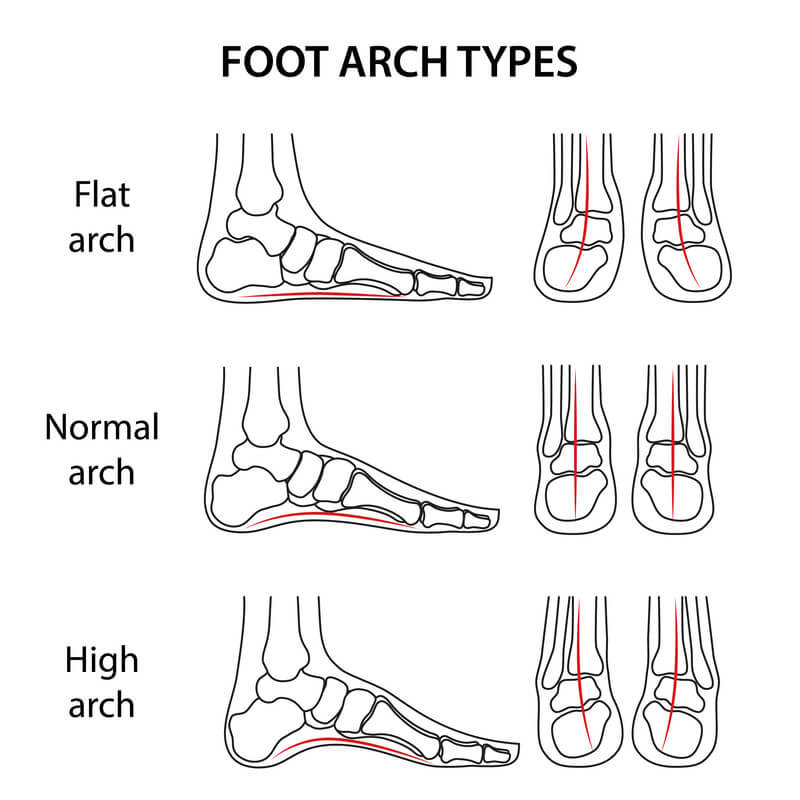
Flat feet (fallen arches) is a foot condition where your feet don’t have a normal arch when you are standing. While it is rarely a serious condition, it can cause pain when you do extensive physical activity. Around 20-30 percent of the population has flat feet.

There are several types of flat foot, all of which have one thing in common: the total or partial collapse of the arch. Flat foot can result in a wide range of different symptoms and different degrees of deformity and disability.
Characteristics of Flat Feet
Some characteristics are shared by most people that have flat foot.
- The inside of the arch (instep) flattens on the floor when standing
- The ankle appears to turn in, with the heel tilting towards the outside
- The toes and the front part of the foot point outward, resulting in “toe drift”
- Hammertoes and bunions are more likely to develop due to a flat foot.
- A higher likelihood of a tight Achilles tendon, which makes the heel lift off the ground earlier, making flat foot symptoms worse
Causes of Flat Feet
There are various causes of flat feet. A few causes include:
- Arthritis or rheumatoid arthritis
- Foot or ankle injury
- Genetics
- Aging
- Pregnancy
- Weak arches
- Nervous system or muscle diseases like spina bifida, muscular dystrophy, and cerebral palsy
- Damage, rupture, or dysfunction of the posterior tibial tendon
- Hypertension
- Diabetes mellitus
You are also more likely to have flat feet if
- The condition runs in your family.
- You are physically active.
- You have diseases that impact the muscles and nervous system.
Some people are born with flat feet, and others develop the condition due to medical conditions, age, and daily use.
Types of Flat Feet
There are various types of flat feet.
Flexible Flat Foot
One of the most common types of flat foot is a flexible flat foot. This is when the arches in your feet only appear if you lift your foot completely off the ground, and the soles of your feet only touch the ground fully when you place your feet on the ground. Flexible flat foot generally starts in childhood and doesn’t cause any pain.
Tight Achilles Tendon
The Achilles tendon is the tendon that connects your calf muscles to your heel bone. When it gets too tight, this can cause pain when walking and running. A tight Achilles tendon can also cause your heel to lift up before it should when you are walking or running.
Posterior tibial tendon dysfunction
The third type of flat foot is when the tendon that connects your calf muscle to the inside of your ankle ends up torn, injured, or swollen. When that tendon doesn’t give your arch the support that it needs, you experience pain on both the inside of your ankle and foot. This type of flat foot can occur on both feet.
Diagnosing Flat Feet
In order to diagnose flat feet, Dr. Melissa Wawrzynek examines your foot when you are sitting down and standing up. Then, an X-ray is generally taken to determine the seriousness of the condition.
Treatment Options for Flat Feet
Treatment options for flat feet vary based on the type of flat foot you have. Treatment options range from noninvasive to surgical intervention to improve function for patients and reduce foot pain.
If you think you have flat feet, the best thing you can do is get an examination and have your doctor develop a treatment plan for you.
Nonsurgical Flat Feet Treatment Options
There is a wide range of nonsurgical treatment options for flat foot.
- Shoe Modification. If you have flat foot, you will want to wear shoes that provide arch support to make up for the lack of support in your foot.
- Medication. If you are experiencing pain and inflammation, nonsteroidal anti-inflammatory drugs (NSAIDs) such as ibuprofen can be useful.
- Orthotic device. You can have custom orthotic devices made for your shoes to ensure you have the arch support you need.
- Activity Modification. Sometimes, you just need to give your arches a rest. Taking a break from prolonged walking and standing, and cutting down on other activities that make your feet hurt, is sometimes just what your arches need.
- Immobilization. Depending on the severity of your flat foot, you may need to avoid weight-bearing on the impacted foot for a while. In that case, a walking cast may be used.
- Physical Therapy. Different physical therapy modalities can be used to help you get relief from flat foot pain.
- Weight loss. Too much weight on your arches can aggravate your symptoms, in which case, a healthy weight loss plan is recommended to relieve your symptoms.
- Regenerative Medicine. If you suffer a foot injury due to your flat feet, regenerative medicine is a non-invasive way to help your body heal itself.These are just a few of the nonsurgical treatment options that Dr. Melissa Wawrzynek in Prussia, PA, at Advanced Foot & Ankle Wellness Center may suggest if you have flat foot.
These are just a few of the nonsurgical treatment options that Dr. Melissa Wawrzynek in Prussia, PA, at Advanced Foot & Ankle Wellness Center may suggest if you have flat foot.
Surgical Flat Feet Treatment Options
Sometimes, nonsurgical options are not effective at getting rid of the pain. In that case, there is a range of different surgical techniques that can be used to correct and fix flat foot, depending on your foot function and symptoms.
To determine what surgical procedures are best for your situation, Dr. Melissa Wawrzynek will refer you to a surgeon to discuss surgical treatment options.
Dr. Melissa Will Help Get You Back On Your Feet
Dr. Melissa Wawrzynek is a board-certified foot and ankle specialist and offers a broad range of advanced orthopedic, sports medicine, and regenerative treatments.
Our doctor and her team will consult with you regularly to ensure you return to health and receive the highest quality care.
If you’re ready to return to full speed as quickly, easily, and safely as possible, schedule an appointment today.

